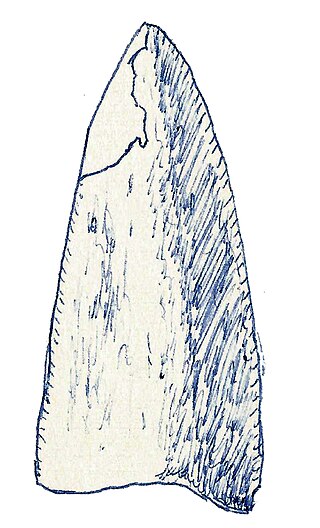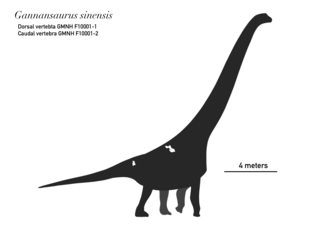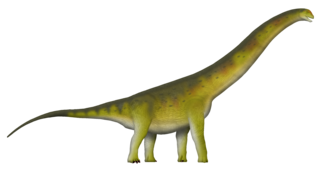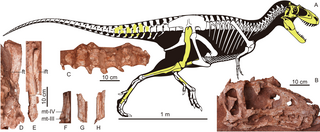
Mamenchisaurus is a genus of sauropod dinosaur known for their remarkably long necks which made up nearly half the total body length. Numerous species have been assigned to the genus; however, the validity of these assignments has been questioned. Fossils have been found in the Sichuan Basin and Yunnan Province in China. Several species from the Upper Shaximiao Formation, whose geologic age is uncertain, have been described. However, evidence suggests this formation to be no earlier than the Oxfordian stage of the Late Jurassic. M. sinocanadorum dates to the Oxfordian stage, and M. anyuensis to the Aptian stage of the Early Cretaceous. Most species were medium-large to large sauropods, measuring roughly 15 to 26 meters in length—possibly up to 35 meters (115 ft), based on two undescribed vertebrae.

Euhelopus is a genus of sauropod dinosaur that lived between 145 and 133 million years ago during the Berriasian and Valanginian stages of the Early Cretaceous in what is now Shandong Province in China. It was a large quadrupedal herbivore. Like sauropods such as brachiosaurs and titanosaurs, Euhelopus had longer forelegs than hind legs. This discovery was paleontologically significant because it represented the first dinosaur scientifically investigated from China: seen in 1913, rediscovered in 1922, and excavated in 1923 and studied by T'an during the same year. Unlike most sauropod specimens, it has a relatively complete skull.

Mongolosaurus is a genus of titanosauriform sauropod dinosaur which lived during the Early Cretaceous of China.

Nanshiungosaurus is a genus of therizinosaurid that lived in what is now Asia during the Late Cretaceous of South China. The type species, Nanshiungosaurus brevispinus, was first discovered in 1974 and described in 1979 by Dong Zhiming. It is represented by a single specimen preserving most of the cervical and dorsal vertebrae with the pelvis. A supposed and unlikely second species, "Nanshiungosaurus" bohlini, was found in 1992 and described in 1997. It is also represented by vertebrae but this species however, differs in geological age and lacks authentic characteristics compared to the type, making its affinity to the genus unsupported.

Daxiatitan is a genus of sauropod dinosaur known from the Lower Cretaceous of Gansu, China. Its type and only species is Daxiatitan binglingi. It is known from a single partial skeleton consisting of most of the neck and back vertebrae, two tail vertebrae, a shoulder blade, and a thigh bone. At the time of its discovery in 2008, Daxiatitan was regarded as potentially the largest known dinosaur from China.

Wintonotitan is a genus of titanosauriform dinosaur from Cenomanian -age Winton Formation of Australia. It is known from partial postcranial remains.
The Nanxiong Formation is a Late Cretaceous geologic formation in Guangdong Province. Dinosaur remains are among the fossils that have been recovered from the formation.

Gannansaurus is an extinct genus of somphospondylan sauropod dinosaur known from the latest Cretaceous Nanxiong Formation of Ganzhou Basin, Jiangxi Province of southern China. It is known from specimen GMNH F10001 which consists of a single, nearly complete dorsal vertebra and a mid-caudal vertebra. Gannansaurus was first named by Lü Junchang, Yi Laiping, Zhong Hui and Wei Xuefang in 2013 and the type species is Gannansaurus sinensis. Gannansaurus shares some characters with Euhelopus, indicating that it is more closely related to it rather than to other titanosauriforms.

Jiangxisaurus is an extinct genus of oviraptorid theropod dinosaur from the Late Cretaceous Nanxiong Formation of southern China. It was similar to Heyuannia, but with more strongly curved anterior claws and a thinner, frailer mandible. This find is paleontologically significant because it contributes to current knowledge about the paleogeographical distribution of oviraptorids in southern China. It was most likely an omnivorous animal along with its close relatives Nankangia and Ganzhousaurus.

Nankangia is an extinct genus of caenagnathoid oviraptorosaurian dinosaur known from the Upper Cretaceous Nanxiong Formation of Nankang County, Ganzhou City of Jiangxi Province, southeastern China. It contains a single species, Nankangia jiangxiensis. N. jiangxiensis coexisted with at least four other caenagnathoids, including but not limited to Corythoraptor, Banji, Ganzhousaurus and Jiangxisaurus. The relatively short dentary and non-downturned mandibular symphysis of Nankangia suggest that it may have been more herbivorous than carnivorous. Its diet consisted of leaves and seeds.

Qianzhousaurus is a genus of tyrannosaurid dinosaur that lived in Asia during the Maastrichtian age of the Late Cretaceous period. There is currently only one species named, the type species Qianzhousaurus sinensis, which is a member of the tribe Alioramini and most closely related to Alioramus, the only other known alioramin.

Huanansaurus is an extinct genus of oviraptorid dinosaur that lived approximately 72 million years ago, between the Campanian and Maastrichtian, during the latter part of the Cretaceous period in what is now China, in the Nanxiong Formation.

Corythoraptor is a genus of oviraptorid dinosaur from the late Maastrichtian Nanxiong Formation of South China. It contains one species, C. jacobsi, known from a single well-preserved skeleton, and named after paleontologist Louis L. Jacobs. It bears a tall crest similar to that of the modern cassowary, and possibly had a similar functionality of display and resonance to detect lower-frequency sounds.

Sibirotitan is a genus of somphospondyl sauropod from the Ilek Formation of Russia. The type and only species is S. astrosacralis.
Punatitan is a genus of titanosaurian sauropod dinosaur from the Late Cretaceous Ciénaga del Río Huaco Formation of La Rioja, Argentina. It contains one species, Punatitan coughlini.

Abditosaurus is an extinct genus of titanosaurian sauropod dinosaur from the Late Cretaceous (Maastrichtian) Tremp Group of Catalonia, Spain. The type and only species is Abditosaurus kuehnei. Phylogenetic analyses recover it within a clade of South American and African saltasaurines, distinct from other insular dwarf sauropods from the European archipelago. Abditosaurus inhabited the Ibero-Armorican Island, a prehistoric island made up of what is now Spain, Portugal, and southern France, and would have been the largest titanosaur species in its environment.
Ruixinia is an extinct genus of somphospondylan titanosauriform dinosaur from the Early Cretaceous (Barremian) Yixian Formation of China. The genus contains a single species, Ruixinia zhangi. The Ruixinia holotype is a partial articulated skeleton with the most complete series of caudal vertebrae known from any Asian titanosauriform.

Garumbatitan is an extinct genus of somphospondylan sauropod dinosaur from the Cretaceous Arcillas de Morella Formation of Spain. The genus contains a single species, G. morellensis, known from multiple partial skeletons.

Gandititan is an extinct genus of titanosaurian sauropod dinosaur from the Late Cretaceous Zhoutian Formation of China. The genus contains a single species, G. cavocaudatus, known from a partial skeleton.

Asiatyrannus is an extinct genus of tyrannosaurine theropod dinosaurs from the Late Cretaceous Nanxiong Formation of China. The genus contains a single species, A. xui, known from a single specimen consisting of a skull and partial postcranial skeleton. Asiatyrannus is notable for its deep-snouted skull and small body size, in contrast to the gracile snout and larger size of the contemporary Qianzhousaurus. It represents the southernmost record of an Asian tyrannosaurid.





























